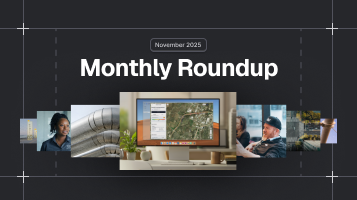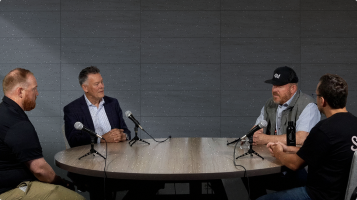The Roadmap to Build Better Together
Written by
.avif)
Chris Garafola
Published on
September 23, 2025

.png)
Table of contents
The utility data ecosystem today is broken.
Accessing reliable utility data can be a major struggle — and if you’re reading this, it’s probably one you’ve experienced firsthand.
Records are often incomplete, inaccurate, or missing altogether. This results in utility strikes, planning errors, the need for rework, delays, and many more consequences.
Most of these outcomes can be traced back to a single root cause: there is no central source of truth for all utility data that is up-to-date, interconnected, and accessible to all stakeholders throughout the project lifecycle.
As planners, designers, and builders of our country’s critical infrastructure, your mission matters deeply to your communities—and reliable data is critical to fulfilling that mission. The consequences of that broken utility data ecosystem affect us all.
A single project might have dozens of stakeholders, but no one’s aligned. Every team is working in siloes based on outdated and incomplete utility data in disconnected platforms, rather than collaborating based on the same shared real-time data.
But what if we could change this? What if we could bring people together earlier in the project lifecycle? What if we could drive better alignment and outcomes? What if we could all instantly access the same reliable data on one platform, available wherever you work, and integrated into the tools, systems, and workflows you already use?
What if we could build better together today?
Utility AI mapping is changing the status quo and enabling collaboration and cooperation across the industry. And 4M is leading the way. Read on for a sneak peek of what’s upcoming in 4M’s product roadmap from our Senior Director of Product Management, Kaustubh Page.
The 4M Product Roadmap
Data Core and Platform
Data is the ultimate value that 4M brings: not only the data itself, but also the ease of access to that data. These questions constantly drive our product roadmap: How can we give access to the data faster? How can we improve our data every day? And how can we bring more evidence to the table?
Surface Object Detection Enhancements
For the next 12 months, we’re doubling down on surface object detection.
Six months ago, we hosted a product roadmap webinar where we discussed on-surface objects. At the beginning, we only had two types in the platform: manholes and poles. But now we have six types of objects: pedestals, manholes, poles, valves, control boxes, and meters.
The list is constantly growing as new ideas come in. For example, as we’re talking to DOTs, one brought up the fact that today’s billboards are digital, meaning they are connected to utilities. Depending on the location of a particular billboard, it may pose a risk to a DOT project, and it would be helpful to identify it as an on-surface object.
Road Markings and AI-Generated Lines
Coming this quarter, we’ll allow users to detect road marks and spray paint and then see AI-generated lines. We’re also working on generating new lines based purely on AI to identify utility lines missing from the records in places with low record coverage.
And finally, you can now click a line to view the data source from which it was derived, improving data visibility and confidence. Soon, you’ll also be able to upload your own internal data set as well to augment that data.
Integrations
The data we just saw looks great, and it’s instantly available. However, if we cannot transfer that data from 4M to another platform, the value of the data diminishes significantly. That remaining silo doesn’t help us build better together. And that’s why we’re also doubling down on our integrations. We already published our WFS integration, and here’s where we’re going next.
Generating 3D Models for Integrations
Let’s start with the Bentley connector, where we can generate a 3D model—not just a map—from our data, and then export that model to Bentley Infrastructure Cloud.
APIs Are Coming Soon
As we’re talking to DOTs and utility owners, they also want to use all this data in their internal tools, for example, for permitting. They’d like to be able to automate how the data is procured through API integrations.
That’s exactly where we’ll go next: we’re creating a REST API for 4M where you can upload a polygon using just APIs and retrieve the data. It will also evolve into supporting AI agentic frameworks, meaning you can query a particular area and ask for risk related to utilities in that area or ask for problematic materials or potential environmental risks in that area.
We’ve also received another request from DOTs and utility owners for a separate API that can provide a list of relevant utility records in the public domain, in their raw form. You can draw a polygon or send it through the API, and it will provide you with a list of all relevant documents for your reference.
Another great example is the FEMA Resiliency Analysis and Planning tool, which allows you to stream data from 4M into the tool and activate additional layers to identify various types of hazards, infrastructure, and census information. This makes it a valuable analytics tool during natural disasters.
Workflows
The final part of our product roadmap involves enriching the workflows. We already have a few workflows in beta, and we’re receiving a great response from the market so far, so we’ll be doubling down on them.
Road and Route Planning
Currently, we have road and transportation planning capabilities that enable us to generate a potential utility conflict matrix in just seconds.
We also offer route planning for utility routes, allowing you to analyze two different paths for a utility line and determine which is the optimal route. Initially, we thought that the feature would be only applicable to utility owners and the AEC industry. However, as we engage with DOTs, we found that they’re interested as well. While the DOTs are not relocating the lines themselves, they can use 4M to obtain a quick relocation estimate, keeping their budgets on track.
The philosophy behind these workflows is that you have better tools, and you can use them to complete these workflows in 4M at a very early and conceptual phase. You can then build better together by streaming data from the outcomes of these workflows into your internal systems.
811 Ticket Automation
We’re also exploring the automation of 811 ticket submissions as an industry-mandatory requirement, and there are numerous optimizations and risk predictions that we could bring to the table here.
For example, a partner recently informed us that their permitting workflow is currently tied to 811 tickets, which is highly manual. Someone has to constantly make sure that tickets are filed on time and refreshed in the right time for the permits to happen.
We can solve a significant portion of that ticket management complexity for you by utilizing automation on our platform, so we’re aiming for a streamlined workflow that incorporates that functionality.
Utility Coordination
Lastly, we have utility coordination workflows on the way. As we have these initial risk reports and conflict matrices within our platform, we’re developing a collaboration feature that allows all kinds of stakeholders to come together.
Bringing together utility owners, public owners, engineers, contractors, excavators, and others at the pre-planning stage to discuss how specific conflicts can be resolved will lead to better project execution with fewer budget surprises. See how this works for the city of Greeley:
You can also invite a contact from the coordination workflow into the product itself and show them the type of modification proposed before design even begins, with privacy protections so they only see the lines or utilities they own.
Help Shape What’s Next
We all win when we build better together. Don’t take our word for it—we asked industry leaders at a recent event in Colorado to tell us why the industry is better together. Their answers were illuminating.
If you also want to drive building better together, join our early access group. You’ll gain access to all the upcoming features we just discussed in 4M and have the opportunity to influence the final product through your feedback.
To dive into even more detail, watch the full webinar on how we’re enabling the whole industry and all of our communities to build better together.
Recent blog posts

Our Newsletter
Join 7k infrastructure professionals
Get monthly insights on ways to build smarter, faster and safer with Utility AI.





